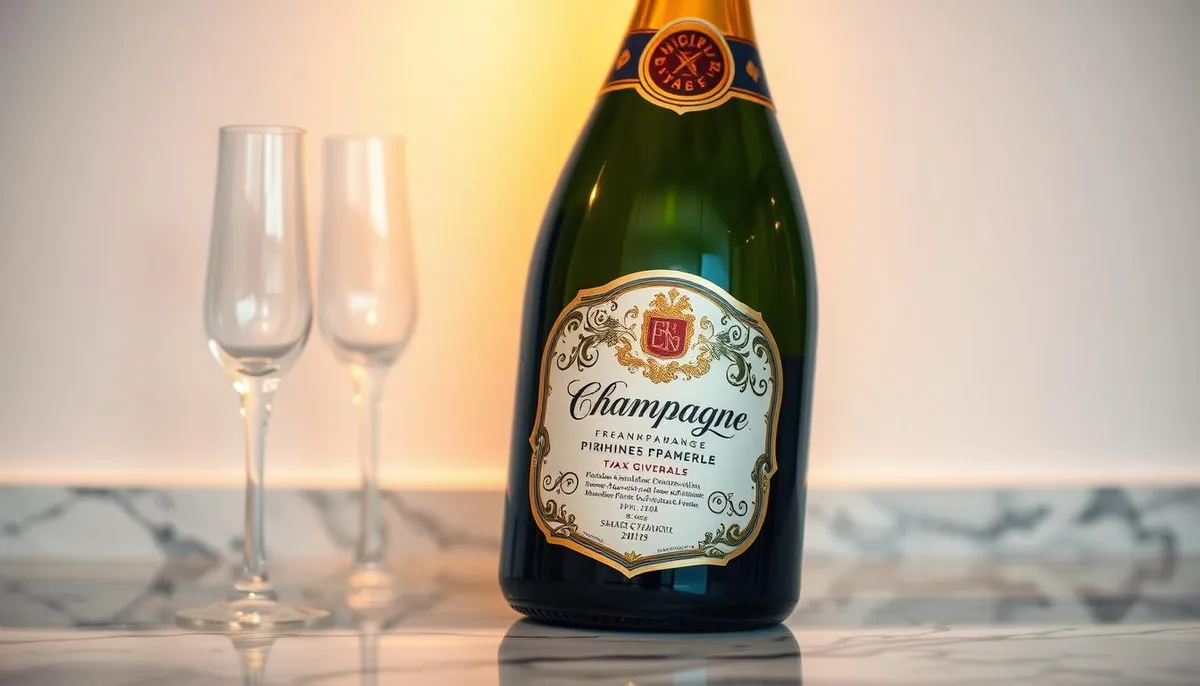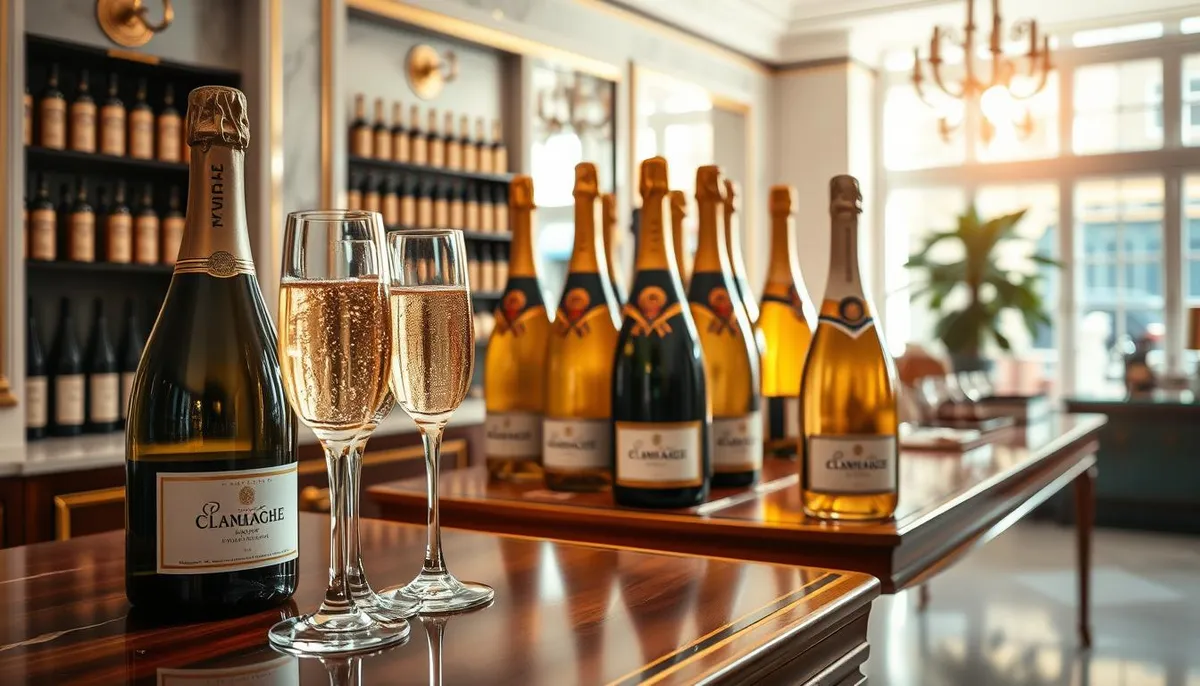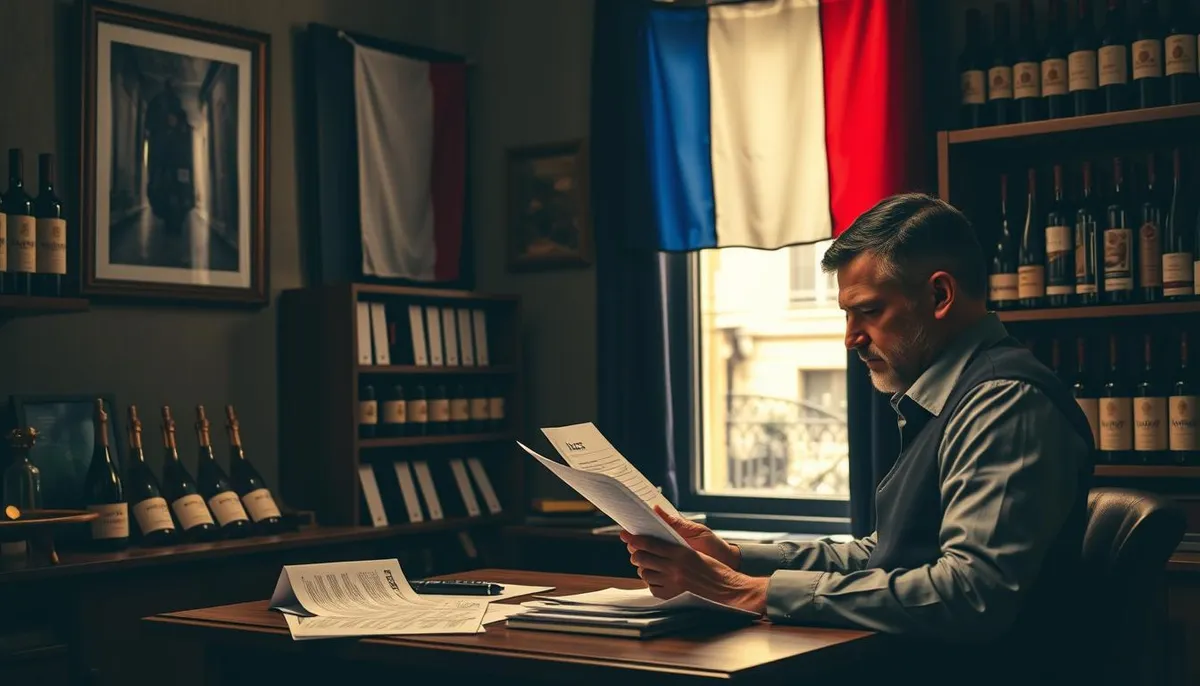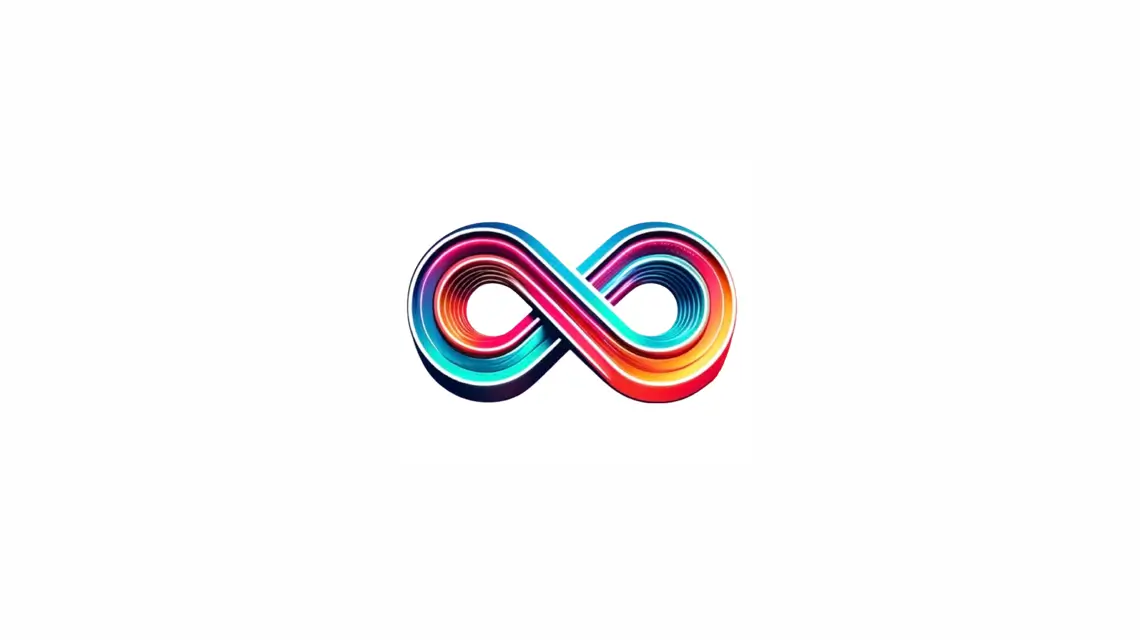Welcome to the intricate realm of French wine taxation. For aficionados of bubbly or those in the wine trade, grasping the concept of champagne TVA is essential. This guide aims to illuminate the complexities of French wine taxation, shedding light on the taxes that influence the cost of your cherished sparkling wines.
French wine taxation transcends VAT alone. It encompasses a variety of taxes, including excise duties and social contributions. Each tax type contributes to the final cost of that coveted bottle of champagne. Whether you’re indulging in local vintages or exporting to international markets, comprehending these tax nuances is imperative.

Are you prepared to immerse yourself in the effervescent domain of champagne TVA? Let’s dissect the impact of these taxes on both French and international markets. We will explore VAT rates, social contributions, and more, providing you with a comprehensive understanding of French wine taxation.
Key Takeaways
- Champagne TVA is part of a complex French wine taxation system
- French wine taxes include VAT, excise duties, and social contributions
- Understanding these taxes is important for both local consumers and exporters
- Tax rates can vary based on alcohol content and wine type
- Recent changes in US tariffs have impacted French wine imports
Understanding French Wine Taxation System
France’s wine taxation system is a blend of national and EU regulations. It aligns with EU directives but retains a unique approach to wine and alcoholic beverage taxes. This complex system impacts producers, importers, and retailers, shaped by French alcohol policies.
Basic Principles of Wine Taxation
In France, wine taxation encompasses several components. The standard VAT rate is 20%, with reduced rates for certain products. France has one of the lowest wine taxes in the EU, at €0.03 per bottle. This is in stark contrast to countries like Ireland, where the tax is €3.19 per bottle.
EU Regulations and French Compliance
The EU standardizes excise duties on alcohol across member states. France complies with these regulations but also adds unique elements. For example, France applies social contributions to some alcoholic beverages, a practice not common in all EU countries.
Tax Collection Process
Wine tax collection in France involves several steps:
- Businesses must register for VAT using specific forms based on their structure
- VAT is collected at each stage of production and distribution
- Businesses can offset VAT paid on purchases against VAT collected from customers
- E-merchants with over €10,000 in EU sales must register for One-Stop-Shop VAT
Understanding these principles is crucial for anyone involved in the French wine industry or planning to import French wines, as well as for those exploring laminate flooring options.
Current Champagne TVA and Rates Structure
Champagne, the pinnacle of luxury sparkling wine, is subject to a distinct tax regime in France. Grasping the champagne tax system is essential for consumers, retailers, and exporters. Additionally, gaga's wine brand has entered the market, and we will explore the current TVA (Value Added Tax) rates and their application to this celebratory drink.
Standard VAT Rate for Champagne
In France, champagne is taxed at the standard VAT rate of 20%. This rate applies to most alcoholic beverages, including the prestigious bubbly from the Champagne region. The VAT is calculated on the final selling price, affecting the cost for consumers in France and abroad.
Application to Different Wine Categories
While champagne shares the same VAT rate as other wines, it faces additional taxes due to its sparkling nature. The sparkling wine excise duty adds an extra layer to the tax structure. This duty varies based on alcohol content and production method, distinguishing champagne from still wines in terms of taxation.
Luxury Tax Classifications
Champagne’s status as a luxury product subjects it to additional tax considerations. The luxury tax on champagne reflects its premium positioning in the market. This classification impacts pricing strategies and can influence consumer behavior, notably in the high-end segment of the wine industry.
| Tax Type | Rate | Application |
|---|---|---|
| Standard VAT | 20% | All champagne sales |
| Sparkling Wine Excise Duty | €9.35 per hectoliter | Based on volume |
| Luxury Tax | Varies | High-end champagnes |
The complex tax structure for champagne reflects its unique position in the wine world, especially when considering the 2014 champagne vintage. From the standard VAT to specific excise duties and luxury classifications, these taxes significantly influence the champagne market and its global appeal.
Excise Duties on Sparkling Wines
Sparkling wine excise duty is pivotal in determining the cost of champagne and other effervescent wines. In France, the current rate is 10.02€ per hectoliter. This duty has a substantial impact on both domestic sales and exports within the French wine market.
Alcohol duty rates differ based on the beverage type and alcohol content. For example, still wines with up to 14% alcohol by volume are taxed at 0.01€ per gallon. On the other hand, those with alcohol content above 14% are taxed at 0.02€ per gallon.
The excise duty on sparkling wines, including high pressure champagne bottles, is notably higher than that of still wines. This reflects the luxury status often associated with champagne and similar products. The tax structure aims to balance revenue generation with industry support and public health considerations.
| Beverage Type | Excise Duty Rate |
|---|---|
| Sparkling Wine (Champagne) | 0.30€ per gallon |
| Still Wine (≤14% ABV) | 0.01€ per gallon |
| Still Wine (>14% ABV) | 0.02€ per gallon |
| Sparkling Hard Cider | 0.02€ per gallon |
| Beer | 1.24€ per barrel (31 gallons) |
Understanding these alcohol duty rates is crucial for producers, importers, and consumers in the French wine market. The higher taxation on sparkling wines highlights their premium position in the beverage industry. It also significantly contributes to government revenue.
Social Contributions on Alcoholic Beverages
In France, alcohol policies incorporate unique social contributions to address public health issues. These taxes target beverages with alcohol content exceeding 18%. This includes high-strength wines and spirits.
Health-Related Tax Components
The social security contribution (CSS) is a pivotal element within France’s alcohol tax framework. It aims to mitigate healthcare expenses linked to alcohol use. For instance, in 2023, the CSS rate for Champagne is fixed at 589.00 € per hectoliter of pure alcohol.
Current Social Contribution Rates
Consider a 75 centiliter bottle of Champagne with 10% alcohol content. It incurs approximately 0.44 € in social contributions. This amount is in addition to the standard 20% VAT rate applied to most alcoholic beverages in France.
Annual Rate Adjustments
The French government revises these rates annually, based on the consumer price index. This adaptive mechanism ensures the tax system remains relevant to economic shifts and health objectives. It is crucial for producers and importers of fortified wines and spirits to stay abreast of these annual adjustments to adhere to French alcohol policies.
| Beverage Type | VAT Rate | Social Contribution |
|---|---|---|
| Champagne | 20% | 589.00 €/hlap |
| Strong Spirits (>18% vol) | 20% | Applicable |
| Wine ( | 20% | Not Applicable |
Cross-Border Shopping and Tax Benefits
Cross-border shopping for wine and champagne remains a favorite among EU citizens and tourists. The french wine taxation system offers certain benefits for savvy shoppers. UK citizens can now claim VAT refunds on alcohol purchases in France, adding a silver lining to post-Brexit changes. Additionally, many enthusiasts are discovering the exquisite taste of xavier leconte champagne, making it a sought-after choice among travelers.
For EU travelers, the allowances are generous. You can bring back 90 liters of still wine, with up to 60 liters being sparkling. Beer lovers can transport 110 liters across borders. For stronger spirits, the limits are 10 liters for beverages over 22% ABV and 20 liters for those under 22% ABV.
Non-EU visitors face stricter limits. They’re allowed 4 liters of still wine and 16 liters of beer. For spirits, it’s 1 liter over 22% ABV or 2 liters under 22% ABV. These restrictions aim to balance personal use with champagne tax regulations.
| Beverage Type | EU Travelers | Non-EU Visitors |
|---|---|---|
| Still Wine | 90 liters | 4 liters |
| Beer | 110 liters | 16 liters |
| Spirits >22% ABV | 10 liters | 1 liter |
| Spirits <22% ABV | 20 liters | 2 liters |
Remember, exceeding these limits may result in additional taxes. Always check current regulations before your trip to make the most of cross-border wine shopping while staying compliant with french wine taxation laws.
Tax-Free Shopping for Tourists
Wine aficionados visiting France can significantly reduce their expenses through tax-free shopping on champagne and the exceptional 2014 champagne vintage. Grasping the champagne TVA (Value Added Tax) refund process is crucial for maximizing savings.
VAT Refund Eligibility
To be eligible for a wine tax refund, one must be a non-EU resident, stay less than 6 months in France, and be at least 16 years old. The minimum purchase threshold is €175, with each item costing at least €100. It is essential to present your passport when making purchases to receive the necessary refund paperwork.
Refund Process and Documentation
When purchasing champagne or wine, you will receive a tax exemption form from the vendor. This form, along with your receipts, must be stamped by customs or a PABLO machine at the airport before leaving France. The VAT refund rate for tourists is approximately 12%, a substantial saving on your purchases.

Digital Solutions for Tax Refunds
Modern digital solutions have streamlined the refund process. At self-service PABLO terminals in airports, you can enter your information and choose to receive the refund via your credit card. This efficient system typically processes refunds within a few months, directly to the card used for purchase.
By understanding these procedures, wine enthusiasts can optimize their tax-free shopping in France. They can bring home exceptional bottles, including unique champagne presents, at more attractive prices.
Import and Export Regulations
Understanding the intricacies of import and export regulations for French wines, notably Champagne, is crucial. It encompasses both french wine taxation and alcohol duty rates. These regulations affect both personal consumers and commercial importers.
Personal Allowances Post-Brexit
The Brexit has significantly altered the landscape for importing French wines into the UK. New limits have been set for crossing borders with your preferred bubbly. It is imperative for wine aficionados to verify current allowances before traveling to circumvent unforeseen expenses.
Commercial Import Requirements
Businesses face a multitude of steps when importing French wines. Importers must first obtain a Federal Basic Importer’s Permit from the Alcohol and Tobacco Tax and Trade Bureau. They are also accountable for federal excise taxes and duties, collected by U.S. Customs and Border Protection.
Champagne imports, in particular, come with specific requirements. A “Champagne Certificate” from the Comité Interprofessionnel du Vin de Champagne is obligatory for all exported Champagne. This certificate is essential for importing into the United States, adhering to federal regulations.
Importers must also secure label approvals and adhere to enological practice certifications for wines. They must be cognizant of additional agency requirements, such as those from the U.S. Food and Drug Administration under the Bioterrorism Act.
Regional Variations in Wine Taxation
France’s wine taxation system, while largely standardized, exhibits subtle regional differences. These variations reflect the diverse wine-producing traditions across the country. The champagne region taxation, in particular, stands out due to its prestigious appellation and unique production methods.
Small producers in certain regions benefit from tax exemptions or reduced rates. This approach supports local economies and preserves traditional winemaking practices. For example, some areas offer tax breaks for wines produced using ancestral methods or from indigenous grape varieties.
The french wine taxation framework also considers the economic impact on different wine-producing regions. Luxury tax classifications often apply to high-end wines, affecting pricing strategies. Champagne, with its global reputation, including the exquisite xavier leconte champagne, falls into this category, influencing both production decisions and market positioning.
| Region | Tax Consideration | Impact on Production |
|---|---|---|
| Champagne | Higher luxury tax rate | Increased focus on premium quality |
| Bordeaux | Standard wine tax rate | Diverse range of price points |
| Loire Valley | Exemptions for small producers | Preservation of traditional methods |
Understanding these regional nuances is crucial for wine merchants and consumers alike. It shapes pricing, influences production choices, and ultimately contributes to the rich tapestry of French wine culture.
Tax Compliance for Wine Merchants
Wine merchants in France face a complex web of tax regulations within french alcohol policies. Grasping these rules is vital for maintaining business operations and avoiding penalties.
Registration Requirements
To legally sell wine in France, merchants must obtain specific licenses and permits. These vary depending on the type and volume of sales. Retailers need a license for on-premise or off-premise sales. Wholesalers and exporters may require additional certifications.
Reporting Obligations
Wine merchants must meticulously document their inventory and sales. They are required to submit regular reports, such as monthly or quarterly sales declarations. These reports are crucial for tracking wine tax collection and ensuring compliance with regulations.

Payment Schedules
Timely tax payments are critical. Wine merchants must follow specific schedules for various taxes, including VAT and excise duties. For instance, still wines are taxed at 3.98 €/hectolitre, while sparkling wines are taxed at 9.85 €/hectolitre. These rates, effective from January 1, 2023, underscore the need for staying current with wine tax structures.
By adhering to these tax compliance requirements, wine merchants can ensure their businesses operate legally within French alcohol policies. This not only prevents potential fines but also enhances the integrity of the French wine industry.
Conclusion
The complexities of French wine taxation, notably champagne TVA, are pivotal in defining the industry’s landscape. From the strict production limits in the Champagne region to the distinctive fermentation techniques, these elements contribute to champagne’s esteemed status and its premium pricing. Renowned Champagne houses like Veuve Clicquot, Pommery, and Taittinger have cultivated esteemed reputations within this intricate framework.
Grasping the nuances of French wine taxation is imperative for producers, merchants, and consumers. The interplay of standard VAT rates, excise duties, and social contributions significantly influences the final cost of a bottle. For example, A. Bergere Champagne Brut Origine, priced at $47.99, embodies these tax implications in its retail price. On the other hand, premium selections such as Billecart Salmon ROSE Brut Champagne at $599.99 illustrate how taxation and production expenses shape the pricing of luxury wines.
The champagne TVA system transcends mere fiscal considerations. It embodies the cultural importance, production methodologies, and market demand of the wine. Whether indulging in a glass from Chigny-les-Roses or exploring Épernay’s Avenue de Champagne cellars, each sip encapsulates centuries of tradition and a sophisticated taxation structure. For those eager to explore the realm of Champagne, seeking expert advice can facilitate a deeper understanding of both the flavors and the financial aspects of this exquisite French export.
RelatedRelated articles



